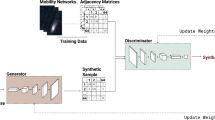Abstract
Simulating user mobility is crucial for mobile computing and spatial database research. However, all existing moving object generators assume a fixed and often unrealistic mobility model. In this paper, we represent the moving behavior as a trajectory in the location-temporal space and propose two generic metrics to evaluate a trajectory dataset. In this context, trajectory generation is treated as an optimization problem and a framework, GAMMA, is proposed to solve it by the genetic algorithm. We demonstrate GAMMA’s practicability and flexibility by configuring it for two specific simulations, namely, cellular network trajectory and symbolic location tracking. The experimental results show that GAMMA can efficiently and robustly produce high quality moving object datasets for various simulation objectives.
This work is supported by the Research Grants Council, Hong Kong SAR under grants HKUST6277/04E and CITYU1204/03E.
Preview
Unable to display preview. Download preview PDF.
Similar content being viewed by others
References
Theodoridis, Y., Silva, J., Nascimento, M.: On the generation of spatiotemporal datasets. In: Güting, R.H., Papadias, D., Lochovsky, F.H. (eds.) SSD 1999. LNCS, vol. 1651, p. 147. Springer, Heidelberg (1999)
Brinkhoff, T.: A framework for generating network-based moving objects. Geoinformatica 6, 153–180 (2002)
Pfoser, D., Theodoridis, Y.: Generating semantics-based trajectories of moving objects. In: International Workshop on Emerging Technologies for Geo-Based Applications, pp. 59–76 (2000)
Wong, W.S.V., Leung, V.C.M.: An adaptive distance-based location update algorithm for next-generation pcs networks. IEEE Journal on Selected Areas in Communications 19, 1942–1952 (2001)
Akyildiz, I., Ho, J., Lin, Y.: Movement based location update and selective paging for pcs networks. IEEE/ACM Transaction on Networking 4, 629–638 (1996)
Chambers, L. (ed.): The Practical Handbook of Genetic Algorithms Applications. Chapman&Hall/CRC (2001)
Jardosh, A., Belding-Royer, E., Almeroth, K., Suri, S.: Towards realistic mobility models for mobile ad hoc networks. In: Proceedings of the ACM/IEEE MobiCom Conference, pp. 217–229 (2003)
Broch, J., Maltz, D.A., Johnson, D., Hu, Y.C., Jetcheva, J.: A performance comparison of multi-hop wireless ad hoc network routing protocols. In: Proceedings of the ACM/IEEE MobiCom Conference, pp. 85–97 (1998)
Yoon, J., Liu, M., Noble, B.: Sound mobility models. In: Proceedings of the ACM/IEEE MobiCom Conference, pp. 205–216 (2003)
Whitley, D.: A genetic algorithm tutorial. Statistics and Computing 4, 65–85 (1994)
Cerny, E., Faye, P., Pownall, P.: Improved design verification by random simulation guided by genetic algorithms. In: Proceedings of the International Conference on Chip Design Automation, ICDA (2000)
Baldi, M., Corno, F., Rebaudengo, M., Squillero, G.: Ga-based performance analysis of network protocols. In: Proceedings of 9th International Conference on Tools with Artificial Intelligence (ICTAI), pp. 118–124 (1997)
Keogh, E.J., Pazzani, M.J.: Scaling up dynamic time warping to massive datasets. In: Żytkow, J.M., Rauch, J. (eds.) PKDD 1999. LNCS (LNAI), vol. 1704, pp. 1–11. Springer, Heidelberg (1999)
Faloutsos, C., Lin, K.I.: Fastmap: A fast algorithm for indexing, data-mining and visualization of traditional and multimedia datasets. In: Proceedings of the ACM SIGMOD Conference, pp. 163–174 (1995)
Klimasauskas, C.C.: Not knowing your random number generator could be costly: Random generators - why are they important. PC Artificial Intelligence Magazine 16, 52–58 (2002)
L’Ecuyer, P.: Software for uniform random number generation: Distinguishing the good and the bad. In: Proceedings of the Winter Simulation Conference, pp. 95–105. IEEE Press, Los Alamitos (2001)
Zheng, B., Lee, D.L.: Semantic caching in location-dependent query processing. In: Jensen, C.S., Schneider, M., Seeger, B., Tsotras, V.J. (eds.) SSTD 2001. LNCS, vol. 2121, pp. 97–116. Springer, Heidelberg (2001)
Tao, Y., Papadias, D.: Time-parameterized queries in spatio-temporal databases. In: Proceedings of the ACM SIGMOD Conference, pp. 334–345 (2002)
Author information
Authors and Affiliations
Editor information
Editors and Affiliations
Rights and permissions
Copyright information
© 2005 Springer-Verlag Berlin Heidelberg
About this paper
Cite this paper
Hu, H., Lee, DL. (2005). GAMMA: A Framework for Moving Object Simulation. In: Bauzer Medeiros, C., Egenhofer, M.J., Bertino, E. (eds) Advances in Spatial and Temporal Databases. SSTD 2005. Lecture Notes in Computer Science, vol 3633. Springer, Berlin, Heidelberg. https://doi.org/10.1007/11535331_3
Download citation
DOI: https://doi.org/10.1007/11535331_3
Publisher Name: Springer, Berlin, Heidelberg
Print ISBN: 978-3-540-28127-6
Online ISBN: 978-3-540-31904-7
eBook Packages: Computer ScienceComputer Science (R0)




